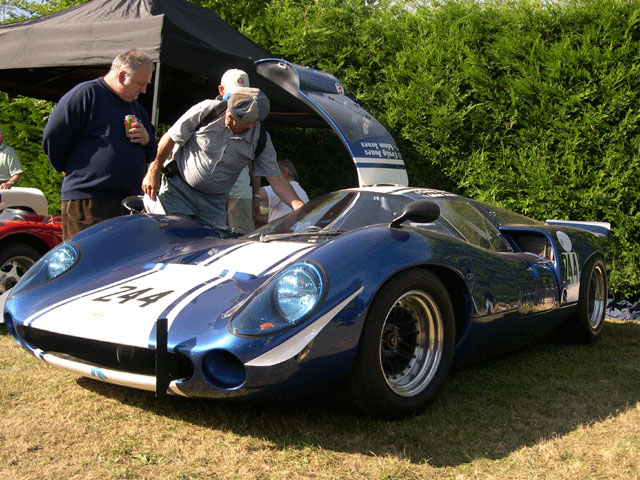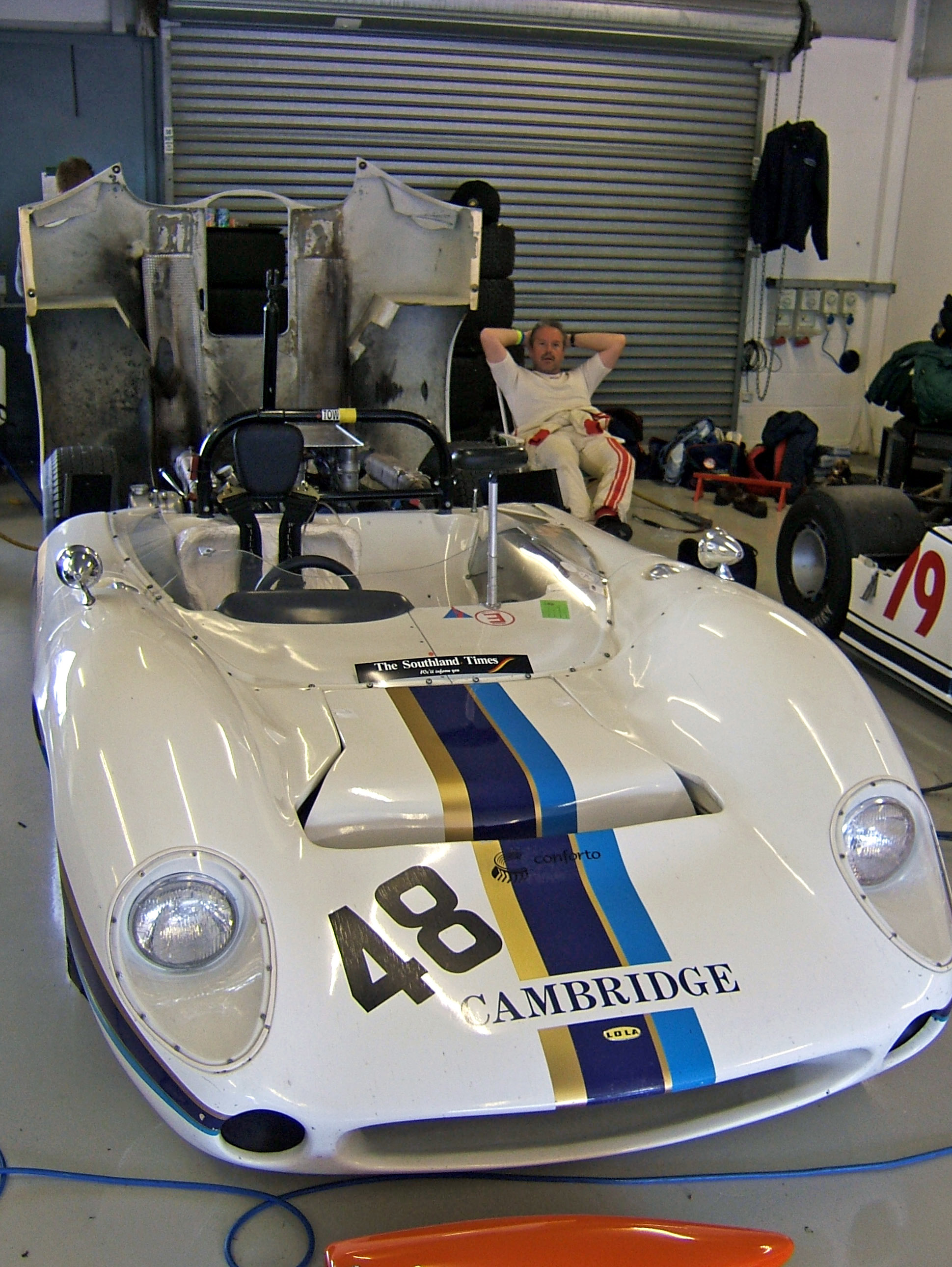Lola T70 on:
[Wikipedia]
[Google]
[Amazon]
 The Lola T70 is a sports prototype developed by British manufacturer Lola Cars in 1965. Lola built the
The Lola T70 is a sports prototype developed by British manufacturer Lola Cars in 1965. Lola built the
 Early success for the Lola T70 came when Walt Hansgen won the Monterey Grand Prix, at
Early success for the Lola T70 came when Walt Hansgen won the Monterey Grand Prix, at  Chevrolet powered coupes tended to suffer reliability problems when racing in Europe, in part due to the grade of fuel allowed. When forced to run on commercially available "pump fuel", with a lower octane rating than the " Avgas" permitted under American rules, engine failures were common. In modern historic racing, these engines show much improved reliability due to parts unavailable in the 1960s and better fuel quality than the historically poor petrol supplied by the ACO.
An Aston Martin powered coupe was entered by Lola for Le Mans in 1967. Even with drivers such as John Surtees, it was a disaster. The Aston Martin V8 engine failed after short runs, attributed to inadequate developmental funds.
During the filming of Steve McQueen's ''Le Mans'', Lola chassis were disguised as the Porsche 917 and Ferrari 512s that crashed in the film. It is claimed chassis T76/141 originally campaigned by Ulf Norinder and Jo Bonnier was used for the wrecked Gulf Porsche. A T70 coupe also appears as a car of the future in
Chevrolet powered coupes tended to suffer reliability problems when racing in Europe, in part due to the grade of fuel allowed. When forced to run on commercially available "pump fuel", with a lower octane rating than the " Avgas" permitted under American rules, engine failures were common. In modern historic racing, these engines show much improved reliability due to parts unavailable in the 1960s and better fuel quality than the historically poor petrol supplied by the ACO.
An Aston Martin powered coupe was entered by Lola for Le Mans in 1967. Even with drivers such as John Surtees, it was a disaster. The Aston Martin V8 engine failed after short runs, attributed to inadequate developmental funds.
During the filming of Steve McQueen's ''Le Mans'', Lola chassis were disguised as the Porsche 917 and Ferrari 512s that crashed in the film. It is claimed chassis T76/141 originally campaigned by Ulf Norinder and Jo Bonnier was used for the wrecked Gulf Porsche. A T70 coupe also appears as a car of the future in
 The Lola T70 is a sports prototype developed by British manufacturer Lola Cars in 1965. Lola built the
The Lola T70 is a sports prototype developed by British manufacturer Lola Cars in 1965. Lola built the aluminium
Aluminium (aluminum in American and Canadian English) is a chemical element with the symbol Al and atomic number 13. Aluminium has a density lower than those of other common metals, at approximately one third that of steel. It ha ...
monocoque chassis
A chassis (, ; plural ''chassis'' from French châssis ) is the load-bearing framework of an artificial object, which structurally supports the object in its construction and function. An example of a chassis is a vehicle frame, the underpar ...
, which were typically powered by large American V8s.
The T70 was quite popular in the mid to late 1960s, with more than 100 examples being built in three versions: an open-roofed Mk II spyder, followed by a Mk III coupé
A coupe or coupé (, ) is a passenger car with a sloping or truncated rear roofline and two doors.
The term ''coupé'' was first applied to horse-drawn carriages for two passengers without rear-facing seats. It comes from the French past parti ...
, and finally a slightly updated Mk IIIB. The T70 was replaced in the Can-Am series by the lighter Lola T160.
History
 Early success for the Lola T70 came when Walt Hansgen won the Monterey Grand Prix, at
Early success for the Lola T70 came when Walt Hansgen won the Monterey Grand Prix, at Laguna Seca Raceway
Laguna Seca Raceway (branded as WeatherTech Raceway Laguna Seca, and previously Mazda Raceway Laguna Seca) is a paved road racing track in central California used for both auto racing and motorcycle racing, built in 1957 near both Salinas and ...
, on 17 October 1965, driving John Mecom's Lola T70-Ford.
In 1966, the hot setup for the Can-Am was a T70 Chevrolet, winning five of six races during the year. John Surtees was the champion and Dan Gurney drove the only Ford powered car ever to win a Can-Am race. In 1967, no one could compete with the new M6 McLaren.
When the FIA changed the rules for sports car racing for the 1968 season, limiting engine size of prototypes to three liters, sportscars with up to five liter engines were allowed if at least fifty were made. This homologation
Homologation ( Greek ''homologeo'', ὁμολογέω, "to agree") is the granting of approval by an official authority. This may be a court of law, a government department, or an academic or professional body, any of which would normally work ...
rule allowed the popular yet outdated Ford GT40 and Lola T70s to continue racing. The Fords won Le Mans
Le Mans (, ) is a city in northwestern France on the Sarthe River where it meets the Huisne. Traditionally the capital of the province of Maine, it is now the capital of the Sarthe department and the seat of the Roman Catholic diocese of Le ...
again in 1968 and 1969, while the T70's only big endurance win was a one–two finish in the 1969 24 Hours of Daytona when the Sunoco Lola T70-Chevrolet of Mark Donohue and Chuck Parsons
Charles W. "Chuck" Parsons (February 6, 1924 – January 3, 1999) was an American sports car racing driver. Parsons drove in SCCA and USSRC competition, then became a driver in the Can Am series. Like many drivers of the era, he participated in mu ...
. headed the American International Racing entry of Ed Leslie and Lothar Motschenbacher. When the minimum number was lowered to twenty five for 1969, the more modern Porsche 917
The Porsche 917 is a sports prototype race car developed by German manufacturer Porsche to exploit the regulations regarding the construction of 5-litre sports cars. Powered by a Type 912 flat-12 engine which was progressively enlarged from ...
and Ferrari 512 were homologated and outran the older Lolas and Fords.
 Chevrolet powered coupes tended to suffer reliability problems when racing in Europe, in part due to the grade of fuel allowed. When forced to run on commercially available "pump fuel", with a lower octane rating than the " Avgas" permitted under American rules, engine failures were common. In modern historic racing, these engines show much improved reliability due to parts unavailable in the 1960s and better fuel quality than the historically poor petrol supplied by the ACO.
An Aston Martin powered coupe was entered by Lola for Le Mans in 1967. Even with drivers such as John Surtees, it was a disaster. The Aston Martin V8 engine failed after short runs, attributed to inadequate developmental funds.
During the filming of Steve McQueen's ''Le Mans'', Lola chassis were disguised as the Porsche 917 and Ferrari 512s that crashed in the film. It is claimed chassis T76/141 originally campaigned by Ulf Norinder and Jo Bonnier was used for the wrecked Gulf Porsche. A T70 coupe also appears as a car of the future in
Chevrolet powered coupes tended to suffer reliability problems when racing in Europe, in part due to the grade of fuel allowed. When forced to run on commercially available "pump fuel", with a lower octane rating than the " Avgas" permitted under American rules, engine failures were common. In modern historic racing, these engines show much improved reliability due to parts unavailable in the 1960s and better fuel quality than the historically poor petrol supplied by the ACO.
An Aston Martin powered coupe was entered by Lola for Le Mans in 1967. Even with drivers such as John Surtees, it was a disaster. The Aston Martin V8 engine failed after short runs, attributed to inadequate developmental funds.
During the filming of Steve McQueen's ''Le Mans'', Lola chassis were disguised as the Porsche 917 and Ferrari 512s that crashed in the film. It is claimed chassis T76/141 originally campaigned by Ulf Norinder and Jo Bonnier was used for the wrecked Gulf Porsche. A T70 coupe also appears as a car of the future in George Lucas
George Walton Lucas Jr. (born May 14, 1944) is an American filmmaker. Lucas is best known for creating the '' Star Wars'' and '' Indiana Jones'' franchises and founding Lucasfilm, LucasArts, Industrial Light & Magic and THX. He served as c ...
' first commercial film, '' THX 1138''.
A T70 Mk. IIIB driven by Mike D’Udy was used to set a South African land speed record, with a two-way average of 191.80 MPH and one-way best of 195.96 MPH, on 13 January 1968. The required runs were made on a section of the R45 between Vredenburg and Hopefield in the Western Cape
The Western Cape is a province of South Africa, situated on the south-western coast of the country. It is the fourth largest of the nine provinces with an area of , and the third most populous, with an estimated 7 million inhabitants in 202 ...
province, and were completed despite an early mechanical failure in which the car's fifth gear was irreparably damaged.
This record would stand until November 1988, when a new two-way average of 224.30 MPH was set by an Audi
Audi AG () is a German automotive manufacturer of luxury vehicles headquartered in Ingolstadt, Bavaria, Germany. As a subsidiary of its parent company, the Volkswagen Group, Audi produces vehicles in nine production facilities worldwide.
...
5000CS driven by Sarel van der Merwe with official backing from Volkswagen
Volkswagen (),English: , . abbreviated as VW (), is a German Automotive industry, motor vehicle manufacturer headquartered in Wolfsburg, Lower Saxony, Germany. Founded in 1937 by the German Labour Front under the Nazi Party and revived into a ...
South Africa.
In 2005, Lola Cars announced a revival of the T70 MkIIIb in "an authentic and limited continuation series" of the original racer. 7 were produced before Lola Cars went defunct in 2012.
Replicas
A UK company, Gardner Douglas, produces the T70 Spyder with styling inspired by the Lola car, and using a tubular spaceframe chassis with GRP panelling. Another British company, Broadley Automotive, makes T70 Mk3B replicas using original moulds and drawings. So authentic they have been granted FIA Historic Technical Passports (HTPs), a number of these Broadley T76s can be seen racing in the FIA Masters Historic Sportscar Championship, where they regularly compete alongside original T70s, Ferrari 512s and Porsche 917s for outright victories. A US company, Race Car Replicas, produces an authentic looking replica of both the MkII and MkIIIB T70 using an aluminium monocoque chassis. A South African company, Universal Products, produces a tubular spaceframe-chassis version, clad in aluminium, of the T70 MkIIIB. Swiss car manufacturer Sbarro produced 13 T70 MKIII.References
Notes
Bibliography
* {{Aston Martin Sportscar Racers Sports prototypes T70 Can-Am cars 24 Hours of Le Mans race cars Group 4 (racing) cars